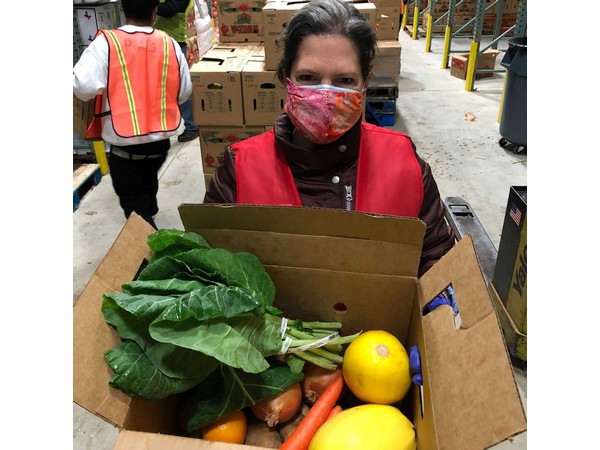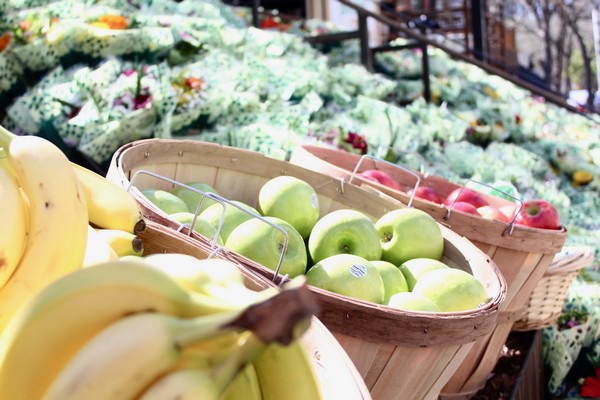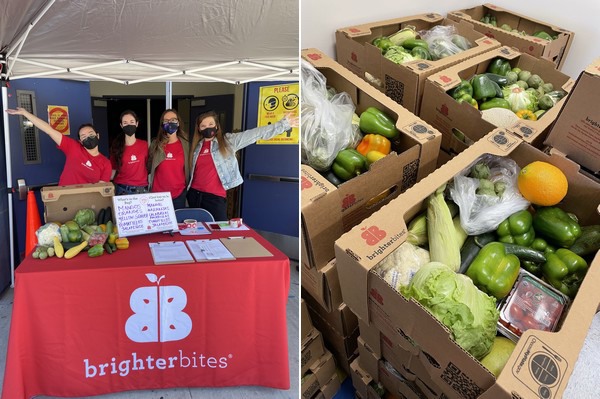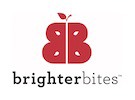Fifty servings of fruits and vegetables a week per family. Nine (soon to be 10) locations. Over 50 million lbs. of produce. More than 500,000 individuals. These are just a few of the numbers that non-profit Brighter Bites has behind its almost 10 years of work with U.S. families.
While at first glance, Houston, TX-based Brighter Bites looks like a food distribution program, they are in fact much more. “We’re a behaviour change organization. Our goal is to change the eating behaviour of elementary school students and their families too,” says Rich Dachman, CEO of Brighter Bites.
Brighter Bites began 10 years ago with founder Lisa Helfman. She saw her then 6-year old son’s eating habits transform following her family’s participation in a fruit and vegetable co-op--so much so that he passed up birthday cake at a party in favor of the blueberries he was craving.
 Brighter Bites distributes fresh produce semi-weekly through schools and camp programs.
Brighter Bites distributes fresh produce semi-weekly through schools and camp programs.
Two more locations
That was the start of an organization that wanted to hand out produce and teach people what to do with it. And since that early start, today it has locations in Houston, Dallas, Austin, New York City, the Washington, D.C. Metropolitan area, Southwest Florida, Salinas, Los Angeles (its most recent opening), a soon-to-be location in Bakersfield, CA, and a Phoenix location before the close of 2022. “This is 10 cities in 10 years and we’re going from one distribution site 10 years ago to almost 450 distribution sites by the end of this year,” says Dachman.
As for how the program operates, it’s almost a two-part system. Via its partner organizations in each city, Brighter Bites distributes fresh produce semi-weekly through schools and camp programs. “We require a minimum of eight varieties to a maximum of 12 varieties and we use a mathematical equation so we don’t repeat those varieties. We can’t keep giving people the same five things every time, even though it’s no cost, because otherwise participation reduces,” says Katherine McMahon, LA regional program director for Brighter Bites. Last week for example, Brighter Bites produce inclusions were Mexican squash, cauliflower, broccoli, pineapple, yucca, pears, mangoes, oranges and asparagus.
Then there’s the educational piece where nutrition education lessons are provided for the classroom along with produce activities and physical education activities. “In many of the schools, there was a huge hole in nutrition education prior to our program. It’s not included in a lot of general curricula,” she says.
 Brighter Bites started with one distribution site 10 years ago and will have almost 450 distribution sites by the end of this year.
Brighter Bites started with one distribution site 10 years ago and will have almost 450 distribution sites by the end of this year.
Involving education
And then there’s direct teacher engagement. “On our distribution days on site, teachers go through with their students what the items are. It’s a wonderful way for students to see that the teachers are receiving the same food they’re receiving and also gets them excited about the program,” McMahon says.
What is also distinct is that Brighter Bites is an evidence-based program that tracks data from beginning to end of the program. For instance, Brighter Bites’ data shows that a three-year commitment to a school is what’s needed to affect consumption behaviour. (Brighter Bites data also shows that 94 percent of participating parents reported their family ate all/most of the fruit provided and 97 percent ate all/most of the vegetables.) Other data points measured include baseline sugar intake, number of servings consumed (one study showed that participants, even two years after the program, were consuming 19 more servings of fruits and vegetables post-program) and plate waste. (Program participation shows significantly less plate waste.)
“We’ve found this program heavily affects the entire family--surveys show that the adults increase fruit and vegetable intake more than the children. So sending home 50 servings of fruits and vegetables is injecting them into a diet that most probably previously was not there,” says Dachman.
 As Brighter Bites looks ahead to the next 10 years, Dachman sees an organization with more funding, support and reach.
As Brighter Bites looks ahead to the next 10 years, Dachman sees an organization with more funding, support and reach.
Employing technology too
To help those families at home too, the organization also has a Brighter Bites app to help families use the food at home and know how best to prepare it.
Now a program like this needs supportive partners, such as the International Fresh Produce Association. In fact, 80 percent of product is donated through partners, such as Food Forward in Los Angeles who not only supplies 100 percent of the Brighter Bites produce there, but also allows the nonprofit to warehouse the food in its facility and have a home office there.
It’s the kind of partnership Dachman more than welcomes. “I want to challenge the produce industry--and I come from them--that when you’re in the fresh produce business, we have a higher cause than just profit,” he says. “We distribute a product that makes a difference in people’s lives and we are the proactive solution to diabetes and obesity. I’m hoping everyone in the industry understands that there’s some portion of giving and the effort they could put out could become a solution to the world with healthier, improved dietary behaviour.”
And as Brighter Bites looks ahead to the next 10 years, Dachman sees an organization with more funding, support and reach. “Within 10 years, we could be the go-to solution because we’re the last mile and an evidence-based produce solution and we provide nutrition that’s so critical,” says Dachman. “Ten years from now it will be an everyday term for people and we will reach millions of families to make a difference.”
 For more information:
For more information:
Jessica Schneider
Brighter Bites
[email protected]
https://brighterbites.org/










